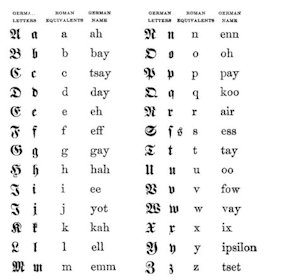
German Alphabet
Although the diacritic letters represent distinct sounds in German phonology,
they are almost universally not considered to be part of the alphabet. Almost
all German speakers consider the alphabet to have the 26 cardinal letters above
and will name only those when asked to say the alphabet.
The diacritic letters ä, ö and ü are used to indicate the presence
of umlauts
(frontalizations of back vowels). Before the introduction of the printing
press, frontalization was indicated by placing an e after the back vowel to be
modified, but German printers developed the space-saving typographical
convention of replacing the full e with a small version placed above the vowel
to be modified. In German Kurrent writing, the superscripted e was simplified
to two vertical dashes, which have degenerated to dots in both handwriting and
German typesetting. Although the two dots look like those in the diaeresis
(trema) diacritical marking, a distinction should be made between umlaut and
diaeresis because the two have different functions.